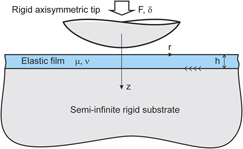Crossref Citations
This article has been cited by the following publications. This list is generated based on data provided by
Crossref.
Meng, Qingshi
Araby, Sherif
Saber, Nasser
Kuan, Hsu-Chiang
Dai, Jiabin
Luong, Lee
Ma, Jun
and
Wang, Chun H.
2014.
Toughening polymer adhesives using nanosized elastomeric particles.
Journal of Materials Research,
Vol. 29,
Issue. 5,
p.
665.
Sohn, Dongwoo
Won, Hyung-Seok
Jang, Bongkyun
Kim, Jae-Hyun
Lee, Hak-Joo
and
Choi, Seung Tae
2015.
Extended JKR theory on adhesive contact between elastic coatings on rigid cylinders under plane strain.
International Journal of Solids and Structures,
Vol. 71,
Issue. ,
p.
244.
Stan, Gheorghe
and
Adams, George G.
2016.
Adhesive contact between a rigid spherical indenter and an elastic multi-layer coated substrate.
International Journal of Solids and Structures,
Vol. 87,
Issue. ,
p.
1.
Argatov, I I
Borodich, F M
and
Popov, V L
2016.
JKR adhesive contact for a transversely isotropic layer of finite thickness.
Journal of Physics D: Applied Physics,
Vol. 49,
Issue. 4,
p.
045307.
Nguyen, Hung K.
Fujinami, So
and
Nakajima, Ken
2016.
Elastic modulus of ultrathin polymer films characterized by atomic force microscopy: The role of probe radius.
Polymer,
Vol. 87,
Issue. ,
p.
114.
Zhu, X
and
Xu, W
2017.
The effect of bottom boundary condition type on the behavior of adhesive contact of spherical probe on an elastic film.
Journal of Physics D: Applied Physics,
Vol. 50,
Issue. 46,
p.
465305.
Zhu, Xinyao
Liu, Lanjiao
Wang, Zuobin
and
Liu, X.
2017.
Axisymmetric Contact Problem for a Flattened Cell: Contributions of Substrate Effect and Cell Thickness to the Determination of Viscoelastic Properties by Using AFM Indentation.
Scanning,
Vol. 2017,
Issue. ,
p.
1.
Liu, Hao
Liu, Wentao
Fujie, Toshinori
and
Nakajima, Ken
2018.
Contact-induced stiffening in ultrathin amorphous polystyrene films.
Polymer,
Vol. 153,
Issue. ,
p.
521.
Lin, Qijing
Zhang, Fuzheng
Han, Feng
Zhao, Man
and
Jiang, Zhuangde
2019.
Influence of surface roughness on the adhesion hysteresis of nano thin film.
Micro & Nano Letters,
Vol. 14,
Issue. 12,
p.
1278.
Nguyen, Vinh Phu
and
Choi, Seung Tae
2019.
Extended JKR theory on adhesive contact of coated spheres.
Acta Mechanica,
Vol. 230,
Issue. 12,
p.
4213.
Stepanov, F. I.
and
Torskaya, E. V.
2020.
3D Contact Problem with Adhesion for Two-Layered Elastic Half-Space.
Mechanics of Solids,
Vol. 55,
Issue. 8,
p.
1308.
Zhang, Lei
and
Ru, C. Q.
2020.
An extended JKR model for adhesion of a rigid sphere on a supported compressible elastic thin layer.
Zeitschrift für angewandte Mathematik und Physik,
Vol. 71,
Issue. 1,
Kim, Seongoh
Lee, Yunkyung
Lee, Manhee
An, Sangmin
and
Cho, Sang-Joon
2021.
Quantitative Visualization of the Nanomechanical Young’s Modulus of Soft Materials by Atomic Force Microscopy.
Nanomaterials,
Vol. 11,
Issue. 6,
p.
1593.
Hermanowicz, Paweł
2021.
Determination of Young’s modulus of samples of arbitrary thickness from force distance curves: numerical investigations and simple approximate formulae.
International Journal of Mechanical Sciences,
Vol. 193,
Issue. ,
p.
106138.
Wu, Yingdan
Dong, Xiaoguang
Kim, Jae-kang
Wang, Chunxiang
and
Sitti, Metin
2022.
Wireless soft millirobots for climbing three-dimensional surfaces in confined spaces.
Science Advances,
Vol. 8,
Issue. 21,
Wang, Kan
Patra, Lokanath
Liu, Bo
Zhang, Zhongtian
Pandey, Ravindra
and
Lee, Bruce P.
2023.
Salicylhydroxamic Acid as a Novel Switchable Adhesive Molecule.
Chemistry of Materials,
Vol. 35,
Issue. 14,
p.
5322.
Torskaya, E. V.
2023.
Modeling of Contact Interaction of Two-Layer Bodies Taking into Account Adhesion and Rheological Properties of Coating or Substrate Materials.
Mechanics of Solids,
Vol. 58,
Issue. 9,
p.
3008.



